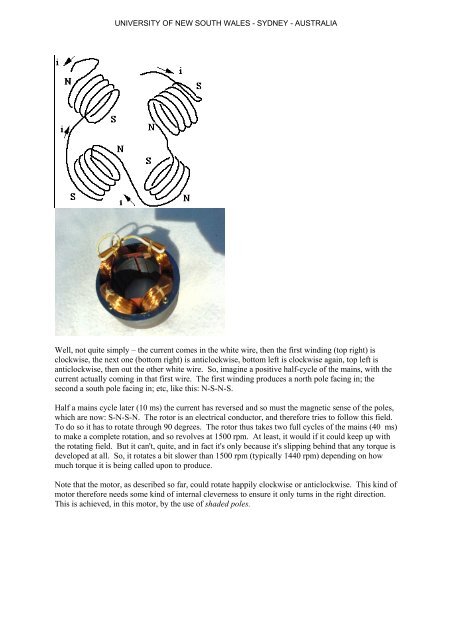How real electric motors work - School of Physics - The University of ...
How real electric motors work - School of Physics - The University of ...
How real electric motors work - School of Physics - The University of ...
Create successful ePaper yourself
Turn your PDF publications into a flip-book with our unique Google optimized e-Paper software.
UNIVERSITY OF NEW SOUTH WALES - SYDNEY - AUSTRALIA<br />
Well, not quite simply – the current comes in the white wire, then the first winding (top right) is<br />
clockwise, the next one (bottom right) is anticlockwise, bottom left is clockwise again, top left is<br />
anticlockwise, then out the other white wire. So, imagine a positive half-cycle <strong>of</strong> the mains, with the<br />
current actually coming in that first wire. <strong>The</strong> first winding produces a north pole facing in; the<br />
second a south pole facing in; etc, like this: N-S-N-S.<br />
Half a mains cycle later (10 ms) the current has reversed and so must the magnetic sense <strong>of</strong> the poles,<br />
which are now: S-N-S-N. <strong>The</strong> rotor is an <strong>electric</strong>al conductor, and therefore tries to follow this field.<br />
To do so it has to rotate through 90 degrees. <strong>The</strong> rotor thus takes two full cycles <strong>of</strong> the mains (40 ms)<br />
to make a complete rotation, and so revolves at 1500 rpm. At least, it would if it could keep up with<br />
the rotating field. But it can't, quite, and in fact it's only because it's slipping behind that any torque is<br />
developed at all. So, it rotates a bit slower than 1500 rpm (typically 1440 rpm) depending on how<br />
much torque it is being called upon to produce.<br />
Note that the motor, as described so far, could rotate happily clockwise or anticlockwise. This kind <strong>of</strong><br />
motor therefore needs some kind <strong>of</strong> internal cleverness to ensure it only turns in the right direction.<br />
This is achieved, in this motor, by the use <strong>of</strong> shaded poles.
















